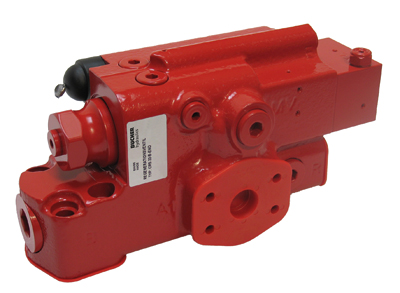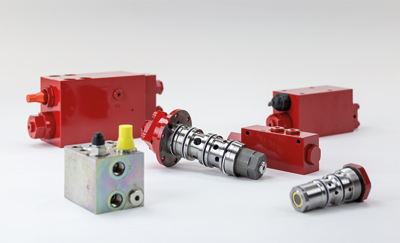Safety valves are critical for protecting equipment and personnel. And, according to officials at Bucher Hydraulics, Neuheim, Switzerland, they can also play a major role in the global competitiveness of mobile machines like cranes and excavators when the focus is on high performance and availability. The company offers an extensive portfolio of safety valves that ranges from application-proven standard products to advanced versions with additional built-in features. And in response to more stringent exhaust-emission regulations, it has now integrated energy-regeneration capabilities into safety valves.

The CINDY-REG series valves (REG stands for regeneration) raise the efficiency in a safety circuit and deliver energy savings of up to 25%. Capabilities reportedly extend far beyond that of a conventional excavator pipe-rupture valve, as the valve controls a load over the entire speed range.
The innovative unit differs from previous designs in that no additional energy is required to retract a cylinder. Instead of controlling lowering operations on mobile vehicles with a conventional counterbalance valve or excavator pipe-rupture valve, a counterbalance valve with “intelligent” regeneration directs a portion of the oil flow into the opposite side of the cylinder. When this volume fills, surplus flow routes to tank with no significant backpressure. The system thus significantly reduces the demand for pump flow, which—depending on the circuit—can then be available to power other operations.
 The CINDY-REG safety valve has a zero-leakage control assembly, fast-acting directly operated pressure relief, and an integral balance valve for tandem applications. It can also incorporate a preload that stabilizes the system in the event of oscillations.
The CINDY-REG safety valve has a zero-leakage control assembly, fast-acting directly operated pressure relief, and an integral balance valve for tandem applications. It can also incorporate a preload that stabilizes the system in the event of oscillations.
This combination of safety functions and energy savings is finding ever-wider use in the material-handling field, in applications such as ship unloading and long-reach excavators. Thus, the CINDY-REG ensures a competitive total cost of ownership (TCO) wherever customers demand shorter cycle times, greater energy efficiency, low maintenance and comprehensive safety, explained experts at Bucher Hydraulics.
Comprehensive valve offerings
The CINDY-REG is but one offering in the company’s overall product family. Five different types of safety valves for handling wide-ranging machine-safety requirements include:
- Basic pipe-rupture valves
- Excavator pipe-rupture valves
- Leak-free load-control valves (CINDY series)
- Spring-loaded counterbalance valves
- Travel brake valves

All are suitable for safety systems that conform to the DIN EN ISO 13849-2 standard. They can be used in industrial and mobile applications, with a particular emphasis on first-rate stability and responsiveness combined with leak-free and energy-efficient operation.
Basic pipe-rupture valves close automatically when flow exceeds set ratings. Such valves are used wherever a load must not be allowed to drop rapidly if a pipe or hose bursts—causing, for example, uncontrolled movement of a cylinder. Normally the valve is open and allows flow in both directions. When actuating flow rate exceeds maximum limits, say due to a hose burst, the pipe-rupture valve closes suddenly and blocks flow without leakage.
Excavator pipe-rupture valves (EPRVs) are used when manufacturers must comply with ISO 8643 and EN 474 requirements for excavators equipped with a lifting device. For example, as soon as a load hook is attached to a bucket, the boom, arm and adjusting cylinders must be safeguarded against a possible pipe burst; and, in the event of an actual failure, prevent uncontrolled lowering or excessive acceleration of the load. In addition, the valve holds the actuator in position when the main valve is centered.
Users can fit these valves to excavators without changing the basic hydraulic system, which may or may not include a material-handling function, because machine behavior remains the same in both cases. Likewise, operators will not notice any difference. This is due to a virtually load-independent, two-stage follower design that features permanently low opening pressures and, even under different loads, retains fine controllability right up to the maximum pressure. At the same time, in closed-loop systems the pilot system has a beneficial effect on energy consumption.
The sophisticated EPRVs have hardened metal seats for durability and reliability, as well as other technical advantages. First, the absence of dynamic seals in the main control axis ensures low hysteresis and stable, unchanging settings. Second, load pressure acts in the closing direction, so the valve closes completely even should the spring break.
Leak-free load-control valves are yet another type of safety valve. These combine load-holding and pipe-rupture functions. They prevent hydraulic actuators from running ahead of the available oil supply and can be used at pressures up to 420 bar with a safety factor of at least 3. Thanks to the particular design of the main control axis, load-control valves offer extremely low leakage.
Again, load pressure acts in the closing direction and maintains safe operation over the entire pressure and flow range. Among their advantages, operation is independent of flow forces. In keeping with the trend toward higher flow rates, these safety valves are available in larger sizes with capacities up to 1,000 lpm.
Over the years, engineers at Bucher Hydraulics have developed many application-oriented systems with these valves. As just one example, they integrated load-control valves into a crane winch that demands the highest levels of safety. Working with the hydraulic motors, the valves ensure reliable closing, and their high opening ratio permits extremely low motor inlet pressures under all load conditions. This is consistent with today’s trend toward increased energy efficiency.
Spring-loaded counterbalance valves typically handle lower flow rates. They are available with various opening ratios as a cost-effective option. Thanks to their special design with a damped actuating piston, these valves provide excellent stability and good controllability.
Travel-brake valves, as the name implies, are an integral part of hydraulic travel drives. The valves prevent drive motors from overrunning when travelling downhill and provide metered braking without cavitation or loss of control. The design safeguards ride comfort through a well-thought-out balance between damping and fast valve response. Depending on the application and available installation space, the valves can be supplied as plate-type, cartridge or SAE flange designs as well as in-line mounting configurations. To withstand often-harsh environmental conditions, valve surfaces are coated with a high quality zinc-nickel finish.
This extensive family of valves helps safeguard the operation of earthmoving and construction equipment, and that demands high reliability. Bucher Hydraulics officials stress that no safety valve leaves the factory without hydraulic testing. This ensures users can select safety valves that meet rigorous safety standards and suit their specific requirements, while the underlying sophisticated technology creates competitive advantages such as higher efficiency and machine availability.
Bucher Hydraulics AG
www.bucherhydraulics.com

